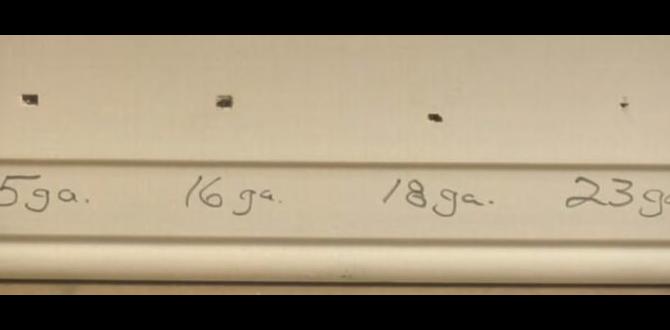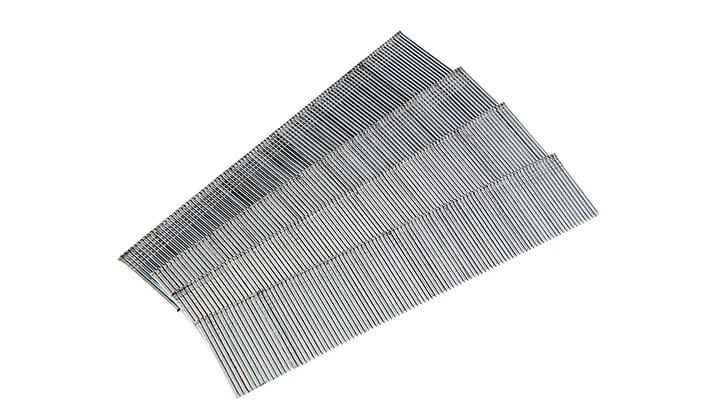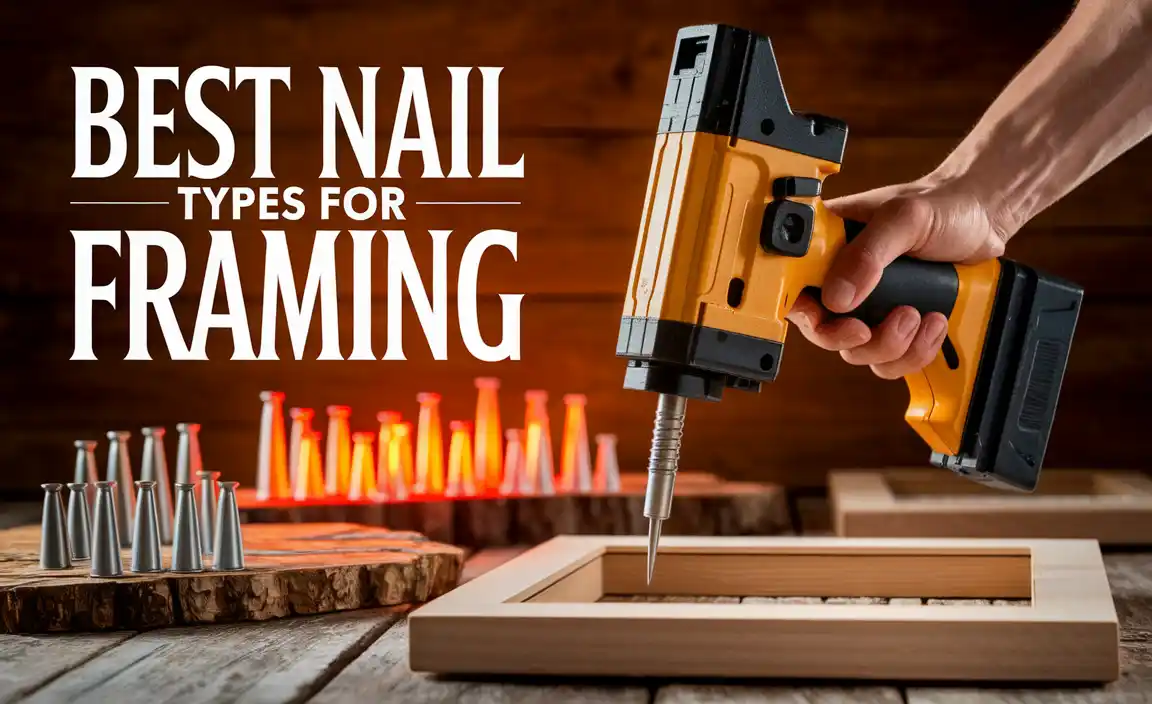Have you ever tried putting up a new baseboard and found it wobbling soon after? Sometimes, the culprit is as simple as using the wrong size of brad nails. Imagine building a toy house with blocks. If the blocks don’t fit, it might tumble. The same happens with baseboards! When the nails aren’t the right size, they can’t hold the baseboard tight. Did you know that picking the right brad nail is like choosing the right puzzle piece? It makes everything fit perfectly. Curious about how to get it right every time? Let’s dive into the world of brad nails and baseboards together!

Table of Contents
Choosing The Right Size Of Brad Nails For Baseboard Installation
When you’re fixing a baseboard, the size of brad nails matters a lot. Don’t use huge ones; they might split the wood. Stick to 1.5 to 2-inch nails. Why? They hold well without causing damage. Imagine trying to fit a giant key into a small lock—it won’t work! Choosing the right size makes all the difference. Ready for a simple home fix? Start with the perfect nail size!
Understanding Brad Nails
Definition and purpose of brad nails. Common materials and sizes of brad nails.
Brad nails are small, thin nails used in woodworking. They are great for attaching baseboards and moldings. These nails have a tiny head, making them almost invisible in wood. Made of steel, they come in various sizes, often between 5/8 inches and 2 inches. Use a brad nailer to drive them in easily. They are perfect for lightweight projects where you want a clean look. Understanding their sizes helps when choosing the right nail for baseboards or other tasks.
What size brad nails for baseboard?
When working with baseboards, the most common size is 1.5 to 2 inches. This size provides good holding strength without splitting the wood. Make sure to match the nail size with your baseboard thickness. This ensures a secure fit.
Why are brad nails thin?
Brad nails are thin to prevent wood splitting. Their small size helps them blend into the surface seamlessly. This makes them ideal for work where appearances matter.
- 1. Get the right tool. Use a brad nailer for easy application.
- 2. Choose the right size, typically 18 gauge.
- 3. Consider the length—1.5 to 2 inches for baseboards.
With these tips, using brad nails becomes simple. That’s why they’re a favorite for many DIY projects, making them perfect for both newbies and pros. Remember to handle them with care, ensuring precise and effective results with minimal effort.
Factors Influencing Brad Nail Size Selection for Baseboards
Thickness of the baseboard material. Wall material and hardness.
Choosing the right brad nail for baseboards is as important as picking the right shoe size. Too big, and it’s like wearing clown shoes; too small, and your baseboard might just tiptoe away! A key factor is the thickness of the baseboard material. Thicker boards need longer nails so they bite better. The wall material matters too. Softer walls might be easygoing, but harder ones will need nails with a bit more backbone.
| Baseboard Material | Nail Length |
|---|---|
| Thin | 1 inch |
| Medium | 1.5 inches |
| Thick | 2 inches |
Can different walls affect nail choice? Absolutely! A concrete wall might make you sweat, but drywall is more of a walk in the park. As one old carpenter said, “Pick the nail like you pick your ice cream—tailored to the taste of the task at hand!” Smart choices lead to a snuggly, lasting hold that keeps baseboards from playing hide and seek.
Guidelines for Selecting Brad Nails Based on Baseboard Material
Recommendations for wood, MDF, and PVC baseboards. How nail size affects finish and holding power.
Choosing the right brad nails for your baseboard depends on the material you use. For wood baseboards, use 18-gauge nails. These are strong for holding and give a nice look. MDF baseboards need 16-gauge nails for better grip. If you have PVC baseboards, use stainless-steel nails; they keep it from rusting.
- Wood: 18-gauge
- MDF: 16-gauge
- PVC: Stainless steel
Why does nail size matter?
Nail size affects how well your baseboard holds. Larger nails are stronger but may leave marks. Smaller nails make a smooth finish. Pick the right size for a neat job.
Small facts: Think of nails like shoes. They need to fit right!
Want more tips about home projects? Keep exploring!
Tools and Techniques for Installing Baseboards with Brad Nails
Essential tools for installation. Installation techniques to ensure secure fitting.
Getting baseboards installed right means having the right tools in your toolbox. Hammer might seem like a friend, but it’s the power nailer that’s the star in this show. It’s quick like a ninja and gives a strong grip to your baseboards. Brad nails join in the fun because they’re perfect in size to hold things snug without causing cracks. Don’t forget your measuring tape; it’s the tool that makes sure your baseboards aren’t shorter than your dad’s jokes! To secure the fitting, start by positioning the boards at the corners. Then nail them in place using zigzag patterns—like you’re dodging rain but with more accuracy.
| Tool | Purpose |
|---|---|
| Power Nailer | Quick and strong attachments |
| Brad Nails | Ensure tight grip without cracks |
| Measuring Tape | Accurate sizing |
Once everything is in place, stepping back to see your clean and well-fitting baseboard is rewarding. Like baking a cake, the process requires a bit of care, but the final look is worth it. And remember, consistency in technique is key; better safe than sorry, because no one likes wobbly baseboards!
Troubleshooting Common Issues in Baseboard Nail Installation
Tips for avoiding splitting and cracking. Solutions for loose or protruding nails.
Nailing baseboards can make you feel like a superhero—until the dreaded issues appear! To avoid splitting and cracking, try using thinner nails. Position nails at a slight angle; it’s like giving them a tiny shield. If nails are loose or sticking out, it means they’re begging for help. Use a hammer to gently tap them back or replace them with the right-sized nails. Remember, a well-fastened baseboard equals a happy house!
| Common Issue | Quick Solution |
|---|---|
| Splitting & Cracking | Use thinner nails at an angle |
| Loose & Protruding Nails | Hammer down or choose the correct size |
As the saying goes, “A nail in time saves nine!” Install like a pro and your baseboards will stand strong and proud.
Expert Tips for a Professional Finish
Strategies for concealing nail holes. Techniques for ensuring alignment and evenness.
Start your baseboard project with a foolproof trick: hide nail holes like a magician! Use a dab of spackling paste and your finger to fill them. For alignment, here’s a secret: stack baseboards on the floor before nailing. It’s like dressing a line of penguins—fun and precise! Keep them steady by employing a level, ensuring they don’t perform the ‘leaning tower’ stunt on your wall. To achieve pro results, opt for brad nails of matching size—not too long or too short. Now, that’s what we call nail-oseum art!
Conclusion
Choosing the right size of brad nails for baseboards is important. Use 1.5 to 2-inch nails for best results. Measure your baseboard first to decide the correct length. Experiment with different lengths if needed. You can learn more by reading helpful guides or asking experts. Now, you’re ready to start your project with confidence!
FAQs
What Is The Recommended Brad Nail Size For Installing Baseboards In A Residential Setting?
When putting up baseboards in your house, use 2-inch brad nails. These nails hold the baseboard securely to the wall. Using the right size helps make sure everything stays in place neatly. If you’re using a nail gun, it makes the job easier and quicker.
How Does The Thickness Of Baseboards Affect The Choice Of Brad Nail Size?
When you choose nails for putting up baseboards (the wooden boards at the bottom of walls), the thickness of the board matters. If the baseboard is thick, you need longer brad nails. Brad nails are small nails used in woodworking. The longer brad nails make sure the board stays on the wall firmly! If the baseboard is thin, shorter brad nails work fine to hold it in place.
Are There Specific Brands Or Types Of Brad Nails That Are Best Suited For Baseboard Installation?
Yes, some brad nails work better for baseboards. Choose 16 or 18-gauge nails because they’re strong and hold well. Brands like Bostitch and DeWalt make good brad nails. Make sure you get nails that match your nail gun. If the nails fit, installation is smoother and your baseboards stay in place.
Can Using The Wrong Size Brad Nails Damage Baseboards Or The Underlying Wall Structure?
Yes, using the wrong size brad nails can cause problems. If the nails are too long, they might go through the baseboard and into the wall, making unwanted holes. If the nails are too short, the baseboards might not stay in place and could fall off. Both cases can mess up the look of the baseboards and wall. Always pick the right size nails for your project to keep everything safe and neat.
How Does The Choice Between Using A Brad Nailer And A Finish Nailer Impact The Nail Size For Baseboard Installation?
When installing baseboards, you have two choices: a brad nailer and a finish nailer. A brad nailer uses smaller nails, called brads. They are good for thin, delicate wood. A finish nailer uses bigger nails, which hold heavy wood better. Choosing which tool to use depends on the size and thickness of your baseboards.






